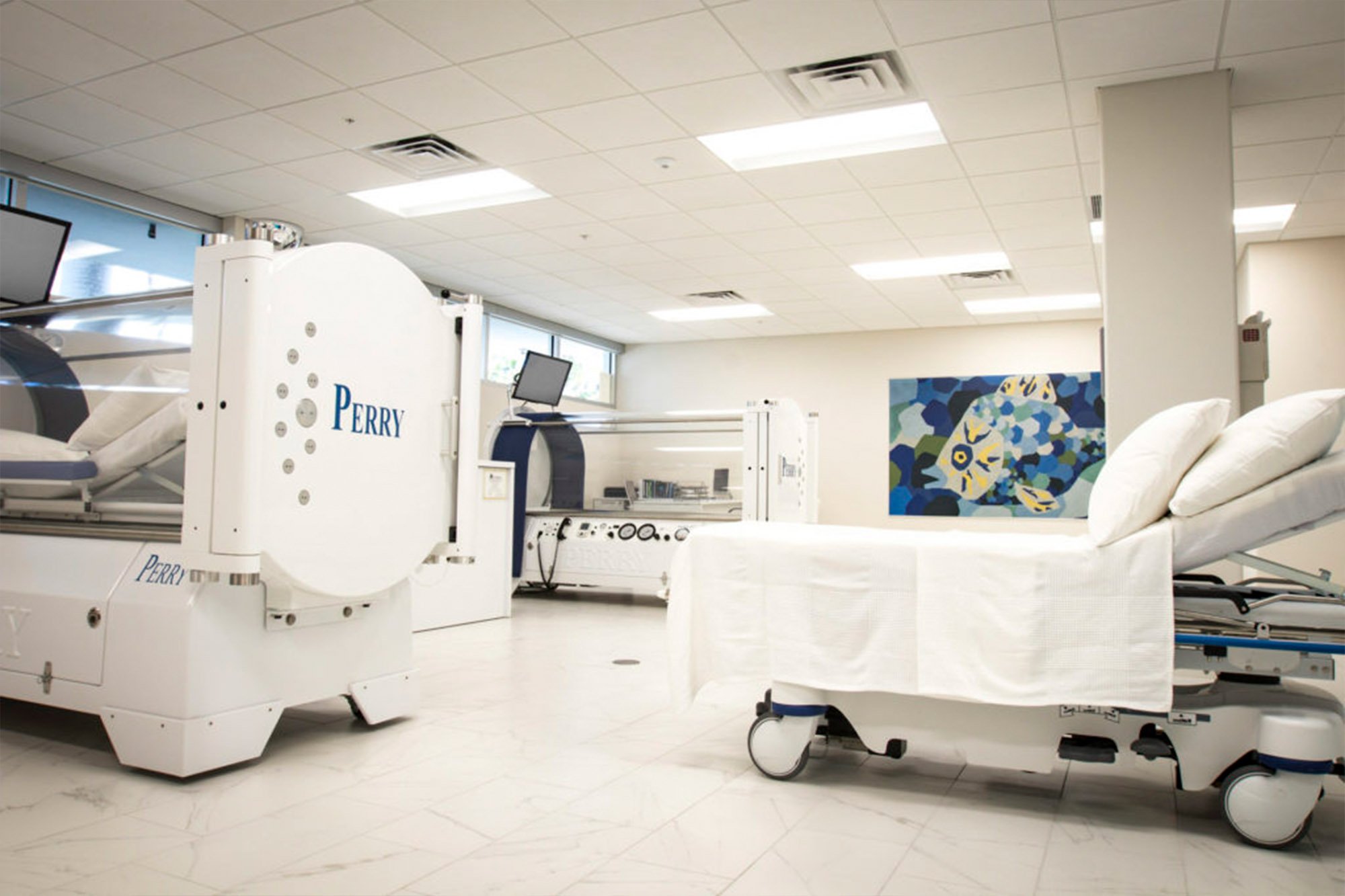For decades, avascular necrosis (AVN) of the femoral head was regarded as a degenerative...
Treating Radiation Damage with Hyperbaric Oxygen Therapy

THIS ARTICLE AT A GLANCE:
Healthy tissue surrounding a tumor that was treated with radiation may be impacted, which may cause new symptoms, referred to as radiation injury. HBOT can target and repair damaged tissue caused by radiation treatment. Hyperbaric oxygen therapy is FDA-approved for latent radiation tissue injuries.
Hyperbaric oxygen therapy has been used in various forms since the 1600s but became more widely recognized for its clinical medicinal uses in the early 19th century. Since then, this innovative technology has assisted many patients in healing from numerous challenges to their health, including side effects from radiation therapy.
Radiation therapy is a cancer treatment that uses radiation beams to directly kill cancer cells and shrink the size of the tumor. There have been advances in how long radiation therapy sessions last and how it is delivered to the target tissue. By targeting tumors more accurately, damage to the surrounding tissue will minimized. These advances are helping decrease complications and expand the use of radiation therapy for different conditions. However, even with those advancements, healthy tissue surrounding the tumor may be impacted, which may cause new symptoms. Post radiation injury is common.
Types of Radiation Tissue Damage
Radiation therapy, while an effective treatment for many cancers, can lead to a condition known as radionecrosis— the death of healthy tissues due to previous radiation exposure. This condition is often associated with late radiation injury, which is also referred to as latent or delayed radiation injury.
Late Radiation Injury
One of the challenges with late radiation injury is that it may not be immediately recognized by physicians. Symptoms of radiation damage can emerge months or even years after the initial treatment, making it difficult for patients and healthcare providers to connect these issues with past radiation therapy. For instance, individuals who have undergone radiation treatment for prostate cancer might experience symptoms like painful urination, blood in the urine, incontinence, rectal pain, or discomfort during bowel movements long after their treatment has concluded. Since these symptoms don’t always appear right away, patients may not associate them with the radiation therapy they received.
The Fibroatriphic Effect
The underlying cause of radiation tissue damage can be explained by the “fibroatrophic effect,” which involves the depletion of STEM cells, the development of fibrosis (the thickening and scarring of connective tissue), and an increase in inflammatory cytokines. This ongoing damage can lead to a breakdown of tissue over time if not addressed through safe and effective medical intervention.
There are several types of latent radiation injuries can occur, including:
-
Radiation Cystitis or Proctitis (Bladder or Prostate Cancer): Patients may experience urinary frequency, pain, burning, or bleeding as a result of radiation treatment.
-
Radiation Tissue Injury after Mastectomy: Women who undergo surgical reconstruction after mastectomy and radiation therapy are at a higher risk for post-operative complications due to poor circulation in the radiated area. Some may develop open sores on their chest that do not heal due to the previous radiation exposure.
-
Dental or Jawbone Problems after Head and Neck Cancer Surgery: Radiation therapy can damage the salivary glands and reduce blood flow, leading to open sores, multiple cavities, fractures of the jaw, and other muscle or skin issues. Swallowing difficulties and neck stiffness can also occur.
-
Bowel Problems after Colon Cancer and Radiation: Common symptoms include diarrhea, urgency, incontinence, and rectal bleeding.
-
Behavioral Changes after Brain Cancer Radiation Therapy: Patients who received radiation therapy for brain cancer might notice changes in personality, memory, or language abilities.
Radiation tissue damage is a serious concern that requires vigilant medical attention, even long after the initial cancer treatment has ended. Understanding the risks and recognizing the symptoms early can help in managing and mitigating the long-term effects of radiation therapy.
Treating Radiation Damage with HBOT
It is estimated that one-third of U.S. hyperbaric oxygen therapy users are being treated for late effects of radiation therapy. Hyperbaric oxygen therapy has been used in various forms since the 1600s but became more widely recognized for its clinical medicinal uses in the early 19th century. Since then, this innovative technology has assisted many patients in healing from numerous challenges to their health, including the effects of radiation.
Hyperbaric oxygen therapy is recognized by the FDA for a number of medical conditions, all of which are generally covered by insurance. HBOT is FDA-approved for latent radiation tissue injuries. Hyperbaric oxygen therapy has been successful with many patients following radiation treatment by improving the oxygenation of the damaged tissues.
Hyperbaric oxygen therapy can target and repair damaged tissue caused by radiation treatment. At Hyperbaric Medical Solutions, we successfully and safely treat this condition over 3,200 times yearly in our practice.
Study Shows HBOT Improves Symptoms in Patients with Radiation Injuries
Research investigating the effects of hyperbaric oxygen therapy on radiation injuries showed that HBOT is a safe treatment modality for radiation therapy induced soft tissue injuries in the pelvic region. Symptoms were alleviated in over 75% of the patients and the improvement in symptoms was lasting, for more than 6-12 months after receiving hyperbaric oxygen therapy.
Most symptoms related to delayed radiation injury can cause major disruption in a patient’s daily activities. HBOT can help improve these symptoms. In a study presented by Cardinal et al., 84% of radiation-induced hemorrhagic cystitis patients had a partial or complete resolution of symptoms. HBOT is even shown to reduce edema, ischemia, and tissue inflammation related to cerebral radiation and offer a neuroprotective effect to the brain. Additionally, in breast cancer patients who received radiation treatments there was reduced pain in the arm and breast areas.
How HBOT Works
Hyperbaric oxygen therapy drives oxygen further into the body, ultimately delivering 10 to 14 times the standard amount of oxygen to damaged tissue. Increasing the oxygen diffusion throughout the body provides the nutrients required to promote healing and recovery. Other processes the body undergoes to heal injuries include anti-inflammatory benefits, altered gene expression and white blood cell enhancement. The production of new blood vessels and the release of stem cells also helps to heal delayed radiation injury.
In a randomized, controlled study evaluating radiation-induced cystitis, symptoms were relieved and the therapy was safe and well tolerated. The treatments must be done in a medical grade hyperbaric chamber at a specific protocol, using pressure of 2.0 to 2.4 ATA. The treatments are time intensive and most patients are advised to receive hyperbaric oxygen therapy five days a week and usually require a minimum of 40 treatments in order to achieve their results. However, the total number of HBOT sessions can vary, depending on a patient's symptoms and his or her initial response to treatment. Usually patients start to notice a change in their condition at the 12 to 15 treatment mark.
Discover the Healing Benefits of HBOT at Hyperbaric Medical Solutions
At Hyperbaric Medical Solutions, we offer a cutting-edge approach to healing through HBOT and other regenerative medicine treatments. Our medical-grade HBOT treatments are delivered under the supervision of highly trained doctors, ensuring the highest levels of safety and effectiveness. With five convenient locations across the east coast, our clinics are easily accessible to those seeking advanced care.
Hyperbaric Medical Solutions is committed to making HBOT accessible and affordable, accepting most major insurance plans. Our centers are equipped with state-of-the-art facilities, where patient safety and comfort are prioritized. Whether you are recovering from radiation tissue damage, dealing with chronic wounds, or seeking enhanced recovery, our expert team is here to support you every step of the way.
Real Patient Cases:
- Case Study: Complete Healing from Painful, Frequent Urination after Radiation Damage from Prostate Cancer Treatment
- Case Study: Delayed Radiation Effects Resolved with HBOT
Supporting Research:
- Delainian. The radiation-induced fibroatrophic process: therapeutic perspective via the antioxidant pathway. Radiother Oncol. 2004
- Cooper JS, Hanley ME, Hendriksen S, et al. Hyperbaric Treatment Of Delayed Radiation Injury. [Updated 2022 Aug 10]. In: StatPearls [Internet]. Treasure Island (FL): StatPearls Publishing; 2022 Jan-. Available from: https://www.ncbi.nlm.nih.gov/books/NBK470447/
- https://pubmed.ncbi.nlm.nih.gov/24035333/
- Cardinal, J., Slade, A., McFarland, M. et al. Scoping Review and Meta-analysis of Hyperbaric Oxygen Therapy for Radiation-Induced Hemorrhagic Cystitis. Curr Urol Rep 19, 38 (2018). https://doi.org/10.1007/s11934-018-0790-3
- Prathivadhi-Bhayankaram, S., , cooper, j. S. Hyperbaric Oxygen Therapy for Cerebral Radiation Necrosis Secondary to Stereotactic Radiation: A Case Series. Graduate Medical Education Research Journal. 2022 Jul 14; 4(1). https://digitalcommons.unmc.edu/gmerj/vol4/iss1/7
- Batenburg, M.C.T., Maarse, W., van der Leij, F. et al. The impact of hyperbaric oxygen therapy on late radiation toxicity and quality of life in breast cancer patients. Breast Cancer Res Treat 189, 425–433 (2021). https://doi.org/10.1007/s10549-021-06332-2
- Nicklas Oscarsson, Bernd Müller, Anders Rosén, Pär Lodding, Johan Mölne, Daniel Giglio, Karin M Hjelle, Guro Vaagbø, Ole Hyldegaard, Michael Vangedal, Lisbeth Salling, Anders Kjellberg, Folke Lind, Otto Ettala, Olli Arola, Helén Seeman-Lodding, Radiation-induced cystitis treated with hyperbaric oxygen therapy (RICH-ART): a randomised, controlled, phase 2–3 trial,
- The Lancet Oncology, Volume 20, Issue 11, 2019, Pages 1602-1614, ISSN 1470-2045.
{Article Updated: Mar 27, 2025}

Written by Alan Katz, MD, FUHM, FACEP, FAAEM
Dr. Alan Katz, National Medical Director of Hyperbaric Medical Solutions (HMS), is double board certified in Emergency Medicine and Hyperbaric Medicine. He directs clinical operations, education and research initiatives, and the integration of other regenerative medicine therapies....
Read More


